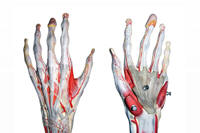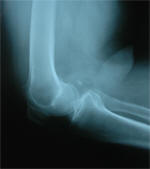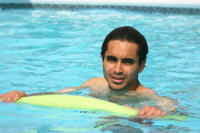|
PT Classroom - Osteoarthritis and Physical Therapy ׀ by Jennifer Hill, MPT, CSCS |
|
According to the Arthritis Foundation, osteoarthritis is the most prevalent form of arthritis in the United States. Nearly one-third of all American adults have X-ray evidence of osteoarthritis in at least one area of their body.
With osteoarthritis an individual’s joint is affected. Anatomically, a joint is formed when two or more bones connect and are held together by ligaments. Certain joints in our body are called synovial joints. The bones that form synovial joints are covered with cartilage. The joint is also surrounded by a tough fibrous tissue called a joint capsule. The joint cavity within the capsule is lined with an inner membrane called the synovial membrane. This membrane secretes synovial fluid which acts as lubrication for the joint. The image provided displays the multiple joints and capsules of the hands.
The cartilage of synovial joints serves two important functions; it acts as a shock absorber and provides a smooth surface for the weight-bearing bones. This cartilage provides a soft, flexible foundation and absorbs the forces of energy produced by joint movement.
In the human body, the hips, knees, shoulders, elbows, wrists, and thumbs are examples of synovial joints. These joints have more mobility than other joints, because of their unique structure. When the mechanical stress placed on the joint is too great, or the joint’s ability to withstand the stress is compromised, physical changes can occur in the cartilage of the joint.
Osteoarthritis, also known as OA, is a complex metabolic disorder of the cartilage and bones of certain joints in the body. In OA, cartilage begins to weaken, becomes frayed, and eventually breaks down. This breakdown of cartilage exposes the underlying bone resulting in the bones of the joint rubbing together. This exposure can lead to pain, the fragmentation of bits of bone and cartilage which breaks off and floats inside the joint, the development of bone spurs on the edges of joints, and the enlargement and inflammation of the bones themselves. The image provided displays an x-ray revealing osteoarthritis of the knee.
The exact cause of OA is unknown. However, there are certain risk factors that appear to be linked to a higher occurrence of OA. These risk factors include: family genetics, repeated trauma to the joint, athletes and people who have extremely physically active jobs, persons with certain bone disorders, and obesity. Excess body weight places additional stresses to the joints and may have adverse effects on the cartilage and shock absorption function of the joint.
Individuals with OA often complain of pain that they describe as a deep ache which often occurs even while resting. With movement, these individuals may experience crepitus, popping or grinding noises, within the affected joint. Joint stiffness and inflammation may also be experienced, and often increases with changes in the weather/humidity.
There are many treatment options available for osteoarthritis. The goals of treatment are to: reduce pain, increase mobility and weight-bearing tolerance, and to minimize any potential permanent disability. Physical therapy is a common treatment option for OA. A physical therapist will assist in developing exercises that are safe and healthy for your joints and body. These exercises can be an excellent way to help keep joints mobile, decrease pain, increase body strength, and decrease overall body weight. Click here to see example exercises: Rehabilitative Exercises for Patients With Knee Osteoarthritis. Aquatic therapy and water aerobics is highly effective with people with OA as well. Aquatic therapy helps to decrease pain because of the therapeutic affect of warm water. Secondary to the buoyancy of the water, it also decreases the weight-bearing stress to the joint, therefore allowing one to move with less pain. If you are able to move through the water, your muscles can become stronger and be able to support your joint better. In addition, the resistance of the water provides excellent strengthening and toning of all of your body’s muscles, which can assist in overall weight loss. Click here to learn more about aquatic therapy exercises: Depth-Specific Aquatic Therapy: Why Pool Depth Matters.
In physical therapy, other treatments may include: paraffin (warm wax applied to the hands or feet), ultrasound, electrical stimulation, soft tissue mobilization/therapeutic massage, and custom foot orthotics. A physical therapist may also help a person with OA improve his/her mobility and walking by analyzing the movement and gait patterns while the person moves. This specialized analysis can help to decrease excess stress to a joint and improve overall mobility throughout the body.
Last revised: August 5, 2008 |
|
|
|
|









